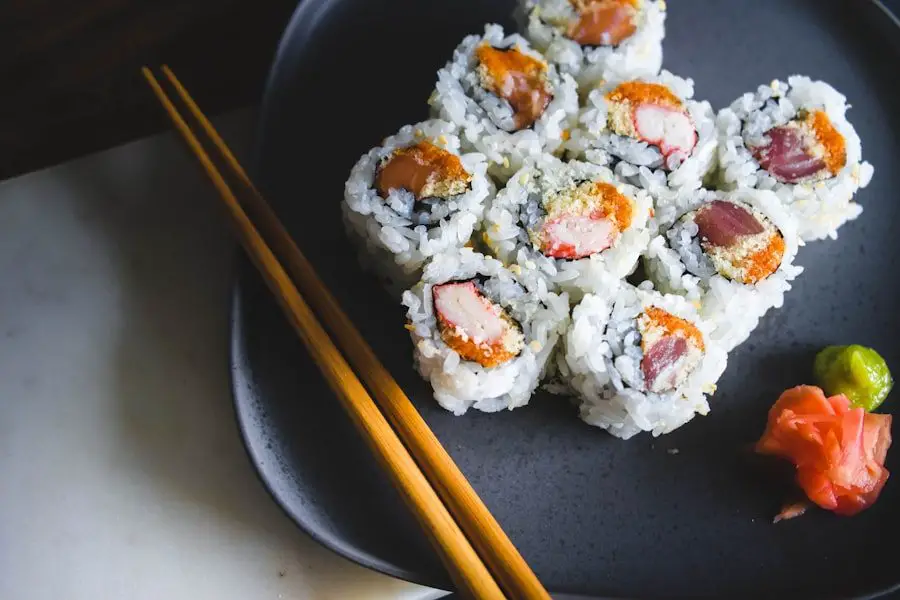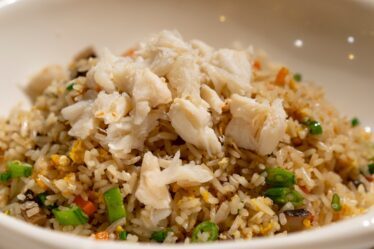
Sushi has a rich and fascinating history that dates back to ancient Japan. The origins of sushi can be traced back to the 8th century, where it was first mentioned in an ancient Japanese dictionary. Originally, sushi was a way of preserving fish by fermenting it with rice and salt.
This process allowed the fish to be stored for months, providing a reliable source of food during the long winter months. Over time, the fermentation process evolved, and the rice was eventually discarded, leaving only the preserved fish. This early form of sushi, known as narezushi, was the precursor to the sushi we know and love today.
In the 19th century, a new form of sushi emerged in Edo, which is now known as Tokyo. This new style of sushi, called nigirizushi, featured fresh fish served over hand-pressed rice. This innovation revolutionized the way sushi was made and consumed, and it quickly gained popularity throughout Japan.
As transportation and refrigeration improved, sushi spread beyond Japan’s borders and became a global phenomenon. Today, sushi is enjoyed by people all over the world, and it has evolved to include a wide variety of ingredients and styles, from traditional nigiri and sashimi to modern sushi rolls and fusion creations. Sushi has come a long way from its humble beginnings as a simple method of preserving fish.
Its evolution over the centuries has been shaped by cultural, technological, and culinary influences, resulting in the diverse and beloved cuisine that we know today. From its origins in ancient Japan to its modern iterations around the world, sushi continues to captivate food enthusiasts with its rich history and delicious flavors.
Key Takeaways
- Sushi has a long history dating back to ancient Japan, where it was originally a way of preserving fish.
- The art of making sushi involves precise techniques and high-quality ingredients, such as sushi rice, fresh fish, and seaweed.
- Eggs play a crucial role in sushi, with tamago (sweet omelette) being a popular choice for nigiri and sushi rolls.
- Sushi variations featuring eggs include tamago nigiri, tamago sushi rolls, and even creative fusion options like egg and avocado rolls.
- Sushi pairs well with sake and other complementary flavors like pickled ginger, wasabi, and soy sauce, enhancing the overall dining experience.
The Art of Making Sushi: Techniques and Ingredients
The Foundation of Sushi: Perfectly Cooked Rice
One of the most critical components of sushi is the rice, which must be cooked to perfection and seasoned with a delicate balance of vinegar, sugar, and salt. The rice serves as the foundation for all types of sushi, providing a neutral yet flavorful base for the toppings and fillings.
The Importance of Fresh and High-Quality Ingredients
In addition to the rice, the quality of the fish and other ingredients is crucial to creating exceptional sushi. Freshness is paramount when it comes to seafood, as it directly impacts the flavor and texture of the final dish. Sushi chefs carefully select and prepare their ingredients to ensure that each piece of sushi is a harmonious blend of flavors and textures.
The Art of Sushi Preparation: Techniques and Traditions
From slicing fish with precision to crafting intricate rolls with finesse, the art of making sushi requires years of practice and dedication. The techniques used in sushi preparation are as diverse as the ingredients themselves. From the precise knife skills required to slice fish for sashimi to the delicate hand-pressing of rice for nigiri, each step in the sushi-making process demands attention to detail and a deep understanding of culinary traditions.
Egg-ceptional Sushi: Exploring the Role of Eggs in Sushi

Eggs play a significant role in traditional Japanese cuisine, and they are a versatile ingredient that adds depth and flavor to many sushi dishes. One of the most iconic egg-based sushi items is tamago nigiri, which features a sweet and savory omelet layered over a small mound of seasoned rice. The preparation of tamago requires skill and finesse, as the eggs are carefully beaten, seasoned, and cooked in a special rectangular pan to achieve the perfect texture and flavor.
The result is a delectable piece of sushi that showcases the delicate balance of sweet and savory flavors. In addition to tamago nigiri, eggs are also used in other types of sushi, such as inarizushi, which consists of seasoned rice wrapped in a sweetened fried tofu pouch. The tofu pouches are typically filled with a mixture of rice and other ingredients, creating a unique and flavorful sushi variation.
Eggs are also used in sushi rolls, where they can be incorporated as a filling or topping to add richness and creaminess to the dish. Whether it’s in the form of tamago nigiri or as a component of other sushi creations, eggs bring a unique and delicious element to traditional Japanese cuisine.
Egg-citing Sushi Variations: From Tamago Nigiri to Sushi Rolls
| Sushi Variation | Description | Ingredients |
|---|---|---|
| Tamago Nigiri | A sweet and fluffy omelette served on top of a small bed of rice | Egg, rice, rice vinegar, sugar, salt |
| California Roll | A popular sushi roll filled with crab meat, avocado, and cucumber | Crab meat, avocado, cucumber, nori, sushi rice, sesame seeds |
| Spicy Tuna Roll | A sushi roll filled with spicy tuna and topped with spicy mayo | Tuna, spicy mayo, nori, sushi rice, cucumber |
| Dragon Roll | A visually stunning sushi roll with eel and avocado on the outside | Eel, avocado, cucumber, nori, sushi rice, eel sauce |
The world of sushi offers a wide array of egg-based variations that cater to different tastes and preferences. Tamago nigiri is perhaps one of the most well-known egg-based sushi items, featuring a sweetened omelet layered over seasoned rice. The preparation of tamago requires skill and precision to achieve the perfect balance of sweetness and texture.
Another popular egg-based sushi variation is tamagoyaki, which is a rolled omelet that is often served as a standalone dish or as part of a sushi platter. The layers of tamagoyaki are carefully rolled into a cylindrical shape, creating a visually appealing and delicious addition to any sushi meal. In addition to nigiri-style egg sushi, eggs are also used in sushi rolls to add richness and flavor.
One popular example is the California roll, which typically includes imitation crab meat, avocado, cucumber, and mayonnaise wrapped in nori seaweed and rice. The addition of eggs in the form of mayonnaise adds creaminess and depth to the roll, complementing the other ingredients for a satisfying flavor profile. Eggs can also be used as a filling for sushi rolls, such as in the case of tamago maki, where slices of sweetened omelet are rolled with nori seaweed and rice to create a delightful and flavorful roll.
Egg-cellent Sushi Pairings: Sake and Other Complementary Flavors
When it comes to enjoying egg-based sushi, there are several complementary flavors and beverages that enhance the overall dining experience. One classic pairing for egg-based sushi is sake, a traditional Japanese rice wine that offers a smooth and slightly sweet flavor profile. The subtle sweetness of sake complements the delicate flavors of egg-based sushi, creating a harmonious balance that delights the palate.
Additionally, sake’s clean finish helps cleanse the palate between bites, allowing diners to fully appreciate the nuances of each dish. In addition to sake, egg-based sushi pairs well with other flavors such as pickled ginger (gari) and wasabi. Pickled ginger serves as a palate cleanser between different types of sushi, while wasabi adds a spicy kick that enhances the overall flavor profile of the dish.
The combination of sweet, savory, spicy, and tangy flavors creates a dynamic dining experience that showcases the versatility of egg-based sushi. Whether enjoyed with traditional accompaniments or paired with other complementary flavors, egg-based sushi offers a delightful culinary journey for food enthusiasts.
Egg-citing Sushi Fusion: How Other Cuisines Have Influenced Sushi

The Latin American Twist
One notable example of this fusion is the incorporation of Latin American ingredients into sushi rolls, giving rise to unique combinations such as spicy tuna rolls with avocado and jalapeño. The addition of Latin American flavors adds a bold and vibrant twist to traditional sushi, appealing to diners who enjoy adventurous culinary experiences.
East Meets West
Another example of sushi fusion is the integration of Western ingredients into traditional Japanese dishes. This can be seen in creations such as tempura shrimp rolls with creamy sauces or sushi topped with foie gras. These fusion dishes blend Japanese techniques with Western flavors, resulting in decadent and indulgent offerings that cater to diverse palates.
A New Era of Sushi Innovation
The fusion of different culinary traditions has expanded the possibilities for sushi, allowing chefs to experiment with new ingredients and techniques to create exciting and innovative dishes.
Egg-citing Sushi at Home: Tips for Making Your Own Delicious Creations
For those who want to try their hand at making egg-based sushi at home, there are several tips to keep in mind for creating delicious and authentic dishes. When making tamago nigiri or tamagoyaki, it’s important to use high-quality eggs that are fresh and flavorful. The eggs should be beaten thoroughly with sugar and mirin (sweet rice wine) to achieve the desired sweetness and texture.
Additionally, using a special rectangular pan for cooking tamagoyaki will help create perfectly shaped layers that are visually appealing and delicious. When making egg-based sushi rolls at home, it’s essential to select fresh ingredients such as avocado, cucumber, and nori seaweed to complement the eggs. Experimenting with different fillings and toppings can add variety and creativity to homemade sushi rolls, allowing home chefs to personalize their creations according to their preferences.
Additionally, serving homemade egg-based sushi with traditional accompaniments such as pickled ginger (gari) and wasabi can elevate the dining experience and provide an authentic touch to the meal. In conclusion, egg-based sushi offers a wide range of delicious options that cater to diverse tastes and preferences. Whether enjoyed at a traditional Japanese restaurant or made at home with personal flair, egg-based sushi provides a delightful culinary experience that showcases the versatility and creativity of this beloved cuisine.
With its rich history, diverse variations, and endless possibilities for fusion creations, egg-based sushi continues to captivate food enthusiasts around the world with its unique flavors and artful presentations.
If you’re a fan of sushi, you may be interested in learning about the health benefits of eggs, which are a great source of protein and vitamin D. In fact, a recent article on Flavorful Sips discusses the importance of incorporating vitamin D-rich foods into your diet, and eggs are a great option for this. To learn more about vitamin D and other nutritious foods, check out their article on vitamin D-rich foods.



